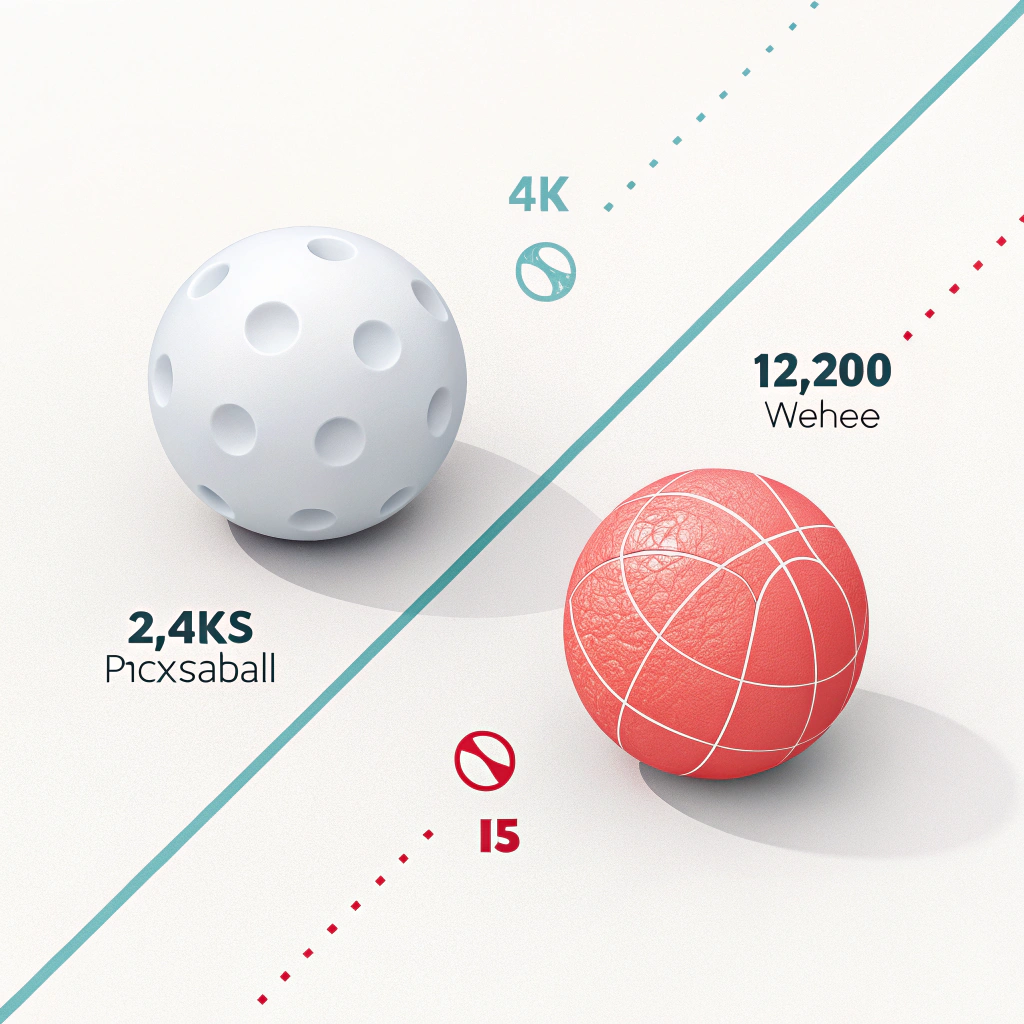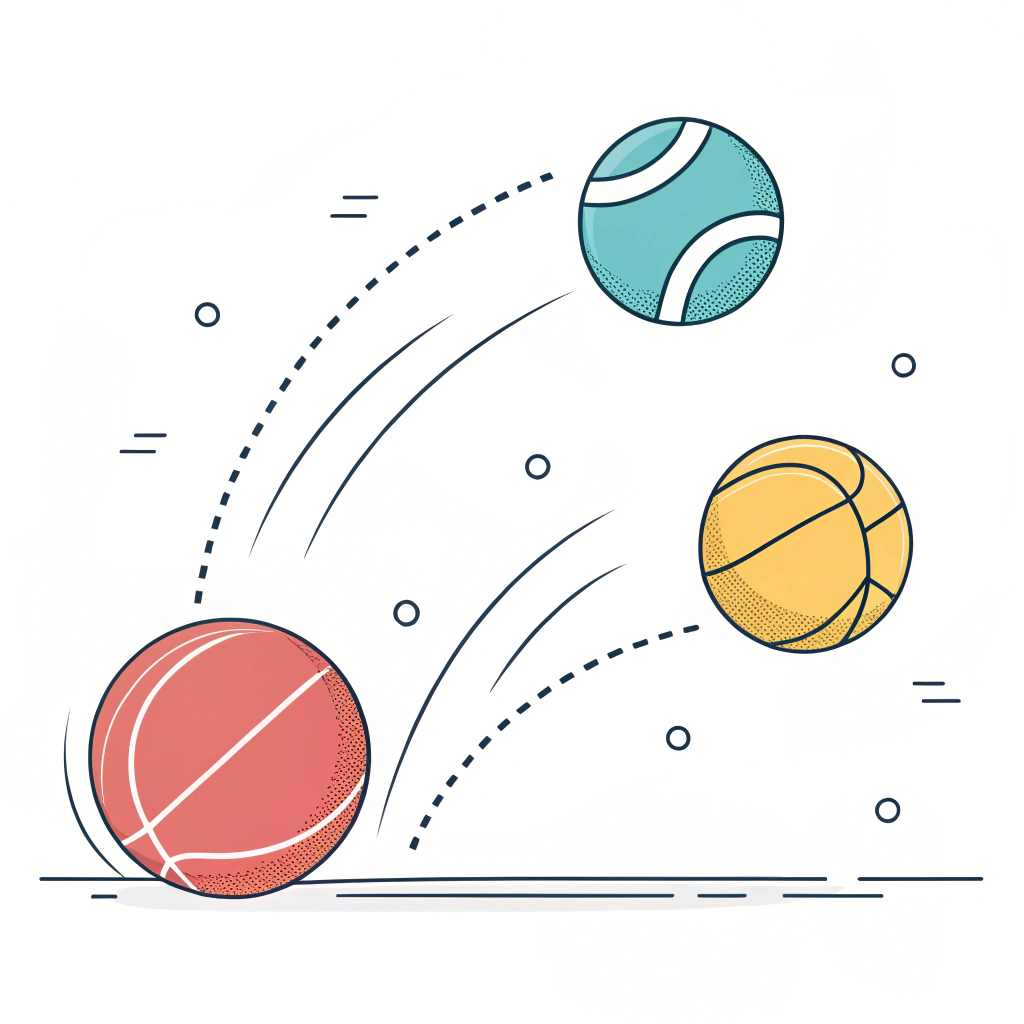For B2B procurement professionals, the key takeaway is that while both pickleball1 and padel ball2 serve as essential sports equipment, they differ significantly in design, material composition, manufacturing standards, and performance characteristics. This detailed, side-by-side comparison will help you understand these differences and make a well-informed procurement decision.
When evaluating sports equipment like padel ball and pickleball, it is crucial to understand that each ball is designed to meet the demands of its specific sport. Padel balls, typically used on smaller courts with walls, are built with slightly different material and performance requirements compared to pickleballs, which are used in a sport that emphasizes controlled bounce and precision play.
Padel balls are known for their slightly smaller size and lower internal pressure, which affects their bounce and durability. In contrast, pickleballs are designed to provide a different playing experience, with specifications that cater to both indoor and outdoor play and emphasize lighter weight and slightly higher bounce dynamics. The differences in design and materials have both technological and market implications for sports clubs and retailers.
The following table provides a direct comparison of key specifications and attributes between pickleballs and padel balls. This side-by-side analysis will enable category managers and procurement professionals to quickly assess which product fits better into their service or retail portfolio.
| Specification | Padel Ball | Pickleball |
|---|---|---|
| Diameter | 6.35 - 6.77 cm | Typically slightly larger; varies by standard |
| Internal Pressure | Lower; designed to offer less bounce | Generally higher to ensure a lively bounce |
| Material Composition | Advanced composites, including 3k, 12k, 18k carbon fiber variants for enhanced durability and performance | Durable plastics or composite materials designed to withstand varied court conditions |
| Manufacturing Process | Utilizes cutting-edge production techniques to ensure precision; often produced with custom pressurized tubes that maintain performance over time | Conventionally manufactured with strict quality controls; may not incorporate advanced composites |
| Usage Environment | Primarily for padel courts with enclosed spaces, allowing for wall rebounds and controlled shots | Outdoor/indoor courts emphasizing quick reflexes and controlled ball placements |
| Quality Assurance | High performance under regulated environmental conditions; strict durability testing | Consistent quality with continual performance monitoring under diverse play conditions |
| Customization3 | High potential for customization in shape, printing, and even integrated grip features in some models | Limited customization options; primarily standardized designs |
This table provides a quick yet comprehensive understanding of the differences, allowing buyers to focus on components most important to their operational needs.
One of the primary considerations for sports equipment procurement is the material quality and manufacturing process4. Padel balls are manufactured using advanced materials that include options such as 3k, 12k, and 18k carbon fiber5 combinations. These materials are selected to optimize durability, control, and performance on the court. In contrast, pickleballs are generally made from high-quality plastics and composite materials designed to maintain performance consistency regardless of environmental conditions.
-
Padel Ball Material:
The manufacturing process for padel balls involves a combination of fiberglass and various grades of carbon fiber to provide both lightweight performance and structural integrity. The lower internal pressure of padel balls means the materials must compensate by delivering excellent resilience and precision. -
Pickleball Material:
Pickleball shells are typically fabricated using durable polymer composites that prioritize rebound performance and impact resistance while being cost-effective. These materials are also chosen to maintain a consistent bounce even as the ball experiences wear.
Modern production techniques focus on precision and quality control. For instance, NEX Padel leverages advanced manufacturing processes to ensure that every padel ball is produced with exacting standards. This includes the use of automated molding systems and rigorous testing of each ball's performance characteristics. For pickleballs, while similar quality control measures exist, the focus has traditionally been on maintaining high production volumes and consistent quality across batches.
Quality assurance plays a pivotal role in long-term customer satisfaction. At NEX Padel, strict quality control procedures ensure that every ball meets the performance criteria required by professionals. This includes:
- Multi-stage testing for durability and performance.
- Customization options for ball design and specifications, typically more advanced in padel ball manufacturing.
- Strict adherence to pressurized tube systems to ensure that the internal pressure remains stable over time, contributing significantly to the ball’s performance on court.
In contrast, pickleballs, while manufactured with high quality standards, offer fewer customization opportunities, which may be a decisive factor for brands wanting to innovate or differentiate their offerings in a competitive market.
Understanding the performance attributes of sports balls is essential for customers who must ensure that the products meet specific operational needs and customer expectations.
-
Padel Ball:
With a slightly lower internal pressure, padel balls demonstrate a controlled bounce, making them ideal for the unique play dynamics of padel courts. The lower bounce contributes to a gameplay style that emphasizes strategy and precision over raw power. Furthermore, the advanced materials used in manufacturing padel balls provide an edge in durability, ensuring the ball withstands the enhanced wear and tear typical of high-intensity matches. -
Pickleball:
Pickleballs are designed to have a relatively higher and more consistent bounce, which is essential for the fast-paced and reflexive nature of the game. The material composition supports both indoor and outdoor performance, with excellent impact resistance. However, the standard materials used might not offer the same level of durability or customization as seen in high-performance padel balls.
The gap in manufacturing techniques between padel balls and pickleballs can impact product selection for B2B purchasers. Padel balls often leverage state-of-the-art production methods driven by technological innovation, which result in highly uniform product characteristics. This consistency is critical for sports facilities that demand precision-engineered equipment.
Pickleballs, while produced under rigorous quality standards, cater more to a mass market, focusing on balancing performance with cost-effectiveness. This dynamic influences procurement decisions based on budget considerations and required performance metrics.
For B2B professionals, the decision to choose one product over the other will depend on several key factors:
-
Sport Specific Requirements:
For facilities or sports clubs that host padel, the need for balls with lower bounce and higher resilience under controlled indoor conditions makes padel balls the preferred option. Conversely, for venues that host pickleball events, the higher bounce and versatility for both indoor and outdoor play are overriding factors. -
Customization Needs:
Brands or clubs looking to personalize their equipment in terms of design, color, or branding are more likely to benefit from the advanced customization options available with padel balls. This is an important consideration for marketing and customer engagement strategies in B2B procurement. -
Cost vs. Performance:
While both types of balls are produced to high standards, the choice might also come down to budget allocation. Advanced composite materials and precision manufacturing in padel balls often come at a premium relative to pickleballs. Procurement officers must therefore balance the enhanced features of padel balls with associated costs and intended usage scenarios.
When making procurement decisions in the high-performance sports equipment industry, several strategic considerations should be taken into account:
-
Market Demand and Product Differentiation:
The growing popularity of padel as a sport has driven a demand for high-performance padel balls that offer customization and superior durability. For market leaders, having a product that meets these elevated standards can create a competitive advantage. -
Regulatory and Industry Standards:
Both padel balls and pickleballs must comply with specific manufacturing and quality standards. It is essential for procurement teams to assess whether suppliers follow internationally recognized standards in durability testing, material composition, and product safety. Certifications and compliance documentation can be significant factors influencing purchasing decisions. -
Supplier Capabilities and Flexibility:
Working with manufacturers like NEX Padel, which offers a range of customization options and personalized solutions (from racket designs to ball specifications), provides flexibility tailored to the unique needs of sports clubs and retailers. This versatility can lead to optimized operational performance and enhanced market positioning. -
Long-Term Value and Innovation:
Investing in products with advanced material compositions and innovative manufacturing techniques can lead to long-term benefits in terms of reduced replacement cycles, consistent performance, and enhanced brand reputation. For businesses, this means improved customer satisfaction and the possibility of commanding a premium in the market. -
Data-Driven Decisions:
Utilizing performance data and comparative analytics ensures that procurement decisions are based on evidence and measurable standards. Detailed specifications such as ball diameter, internal pressure, and material composition should be quantitatively evaluated against operational needs and market expectations.
In summary, the contrast between pickleball and padel ball specifications reveals distinct advantages and limitations that must be carefully considered by B2B professionals. Padel balls, with their advanced material composition, lower internal pressure, and superior customization options, offer a competitive edge for sports facilities focused on the nuances of padel. On the other hand, pickleballs provide consistent, high-bounce performance suitable for a broader range of playing environments while maintaining cost efficiency.
To make an informed purchase decision, procurement teams should:
- Clearly define the operational requirements based on the intended sport.
- Evaluate supplier capabilities, especially around quality assurance and customization.
- Consider long-term product durability and the potential for product differentiation in their market segment.
- Leverage data-driven insights and compare technical specifications side-by-side.
Given the dynamic nature of sports technology and player expectations, a rigorous product differentiation strategy supported by advanced manufacturing standards is crucial. Whether your focus is on high-performance padel courts or the fast-paced world of pickleball, aligning product specifications with market needs will ultimately lead to enhanced customer satisfaction and business growth.
Q: How are padel balls different?
A: Padel balls are designed specifically for padel sports, featuring a slightly smaller size and lower internal pressure compared to other sports balls. This design ensures a controlled bounce suitable for enclosed courts and wall play, which is essential for the unique tactical gameplay of padel.
-
pickleball: Click to read an in-depth guide on pickleball’s unique characteristics, its evolution as a sport, and key factors affecting its performance and procurement. ↩ ↩
-
padel ball: Click to discover the specialized design, material innovations, and performance metrics that differentiate padel balls in the competitive sports equipment market. ↩ ↩
-
Customization: Click to learn about the strategic value and technical options for customization in sports equipment, and how personalized designs can provide a competitive market advantage. ↩ ↩
-
manufacturing process: Click to understand the modern production techniques, quality assurance protocols, and technological innovations driving efficiency in sports equipment manufacturing. ↩ ↩
-
3k, 12k, and 18k carbon fiber: Click to explore the technical specifications and benefits of using various grades of carbon fiber in high-performance sports equipment manufacturing. ↩ ↩







